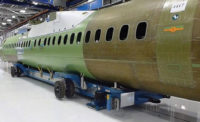
Nissin Brake Ohio specifies modular parts because it simplifies the procurement process and reduces design time. Shown is Nissin’s screw fastening equipment used for automotive assemblies. Photo courtesy Misumi USA Inc.
To produce its diverse and extensive product lineup, Nissin Brake has developed expertise in a wide range of manufacturing processes. Many of its production machines are designed and built in-house. The design engineering process for this equipment is based on part modularity and flexibility.
Nick Fahim, design engineer for Nissin’s ABS modulator department, says Nissan engineers specify modular parts as much as possible for in-house production equipment, because it simplifies the procurement process and significantly reduces the design time for each project. The engineering team often standardizes modular parts sourced from Misumi USA Inc.
After baseline manpower and cycle time numbers are generated for a project, the equipment design engineering process begins. Nissin’s design engineers work together to decide what form the assembly equipment will take, the level of automation, methods of part detection and quality verification, and overall equipment controls.
Next, a 3D design of the equipment is created using Dassault Systems’ SolidWorks software. Nissin engineers use Misumi’s online CAD Configurator to incorporate the SolidWorks file directly into the equipment model.
“We can configure the component part directly to our specifications and have it fit seamlessly into our models,” says Fahim. “In some instances, we have been able to retrieve a quote from our account history and simply reorder all of the parts needed for a particular project that was being duplicated.”
Once the modeling is completed and approved, assembly prints and drawings are created along with the bill of materials, from which all parts are ordered for the project.
To illustrate the benefit of using configurable components, Fahim recalls one recent project that required the building of four machines with a modular design. Fahim says each machine had more than 500 line item parts, but Nissin’s engineers were able to source more than 50 percent of them from Misumi’s online catalog. This resulted in significant time savings, because of vendor reduction, and cost savings, due to quantity discounts.
“In the modular design of the base equipment frame and machine guarding, we used extruded aluminum, which meant that more than 75 percent of the configured components were shared among four machines with different functions,” says Fahim. “We only had to design the first machine completely from scratch. The remaining three simply required changing modules for different functions, such as replacing the dispense valve of one machine with a screw fastening spindle on another.
For more information on modular mechanical components, call 800-681-7475 or visit http://us.misumi-ec.com.






